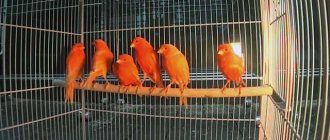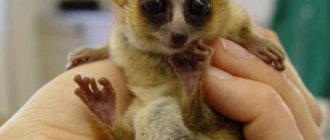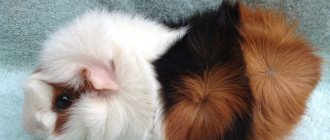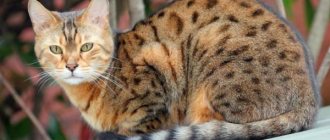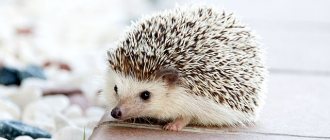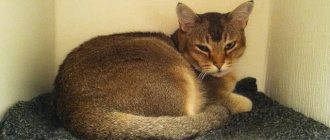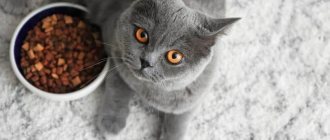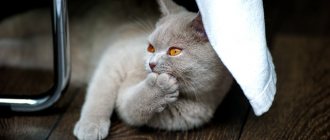basic information
The sacred Birman cat is of medium size, light weight, and belongs to the long-haired type. Beautiful appearance matches a pleasant character.
| Name | sacred birman cat |
| Country of origin | Burma (Myanmar) |
| Type | long-haired |
| Weight | 4-6 kg |
| Age | 12-18 years old |
| EMS code | SBI |
Estimation of breed characteristics
| Adaptability | ***** |
| Problems with shedding | ** |
| Tenderness | ***** |
| Need for communication | ***** |
| Health | *** |
| Grooming | * |
| Attitude towards children | **** |
| Get along with dogs and other pets | **** |
| Activity | ***** |
| Intellectual abilities | ***** |
Description of the breed
These are not the largest representatives of the cat family. A cat weighs about five to six kilograms, and a female cat weighs up to four. Their life expectancy is quite respectable, they live about fifteen years and longer if the animal is provided with good conditions and proper maintenance. High-quality nutrition, coat and ear care, vaccinations, and hygiene are of great importance. He is famous for his flexible character and his intellectual abilities are quite high.
Story
The official history of the sacred cat breed is quite long. It was first recognized in France about a century ago - in 1925. In 1959, representatives came to the United States, and by 1967 they received recognition from various associations. In the 70s they became known in Europe, Australia and New Zealand. They came to Russia in the 90s.
There is a beautiful legend about the appearance of these cats and their acquisition of sacred status. The cat Singh, who lived at the temple of the Indian goddess - the mistress of souls, stood up to protect the priest who died at the hands of bandits. The intervention did not save the priest, but the goddess appreciated Singh’s courage.
Her long white fur was given a golden hue, and her amber eyes became bright sapphire. The edges of the paws remained boiling white, symbolizing the purity of the deceased monk. These changes affected other temple cats, which surprised the servants who returned to the temple after the attack. The legend explains why it is called “sacred” or “holy”.
According to felinologists, the sacred Burma is a product of crossing Angora cats with Siamese. Like Balinese cats, which have a similar origin, they have a soft, silky coat. It is not known whether the breeding process was planned or accidental, or when exactly the mating occurred. The probable place of origin of the breed is considered to be southeast Asia.
There is a version that European individuals took part in the appearance of this variety; this happened in France. Gordon Russell and Auguste Pavy handed over the blue-eyed offspring to the ministers, expressing their gratitude. Regardless of the story, the result was amazingly beautiful cats with unique personalities. Another famous breed from this region is the Burmese, but it looks completely different, it is a short-haired beauty.
Standard
The requirements for the exterior are quite strict. The main parameters of the breed standard are presented in the table:
| Category | Description |
| Wool | Beige, has a golden hue, silky, soft, medium length, on the muzzle there is a “Siamese” mask, short fur, on the paws there are white “socks”. Around the neck, elongated hairs form a resemblance to a lion's mane, and the undercoat is scanty. |
| Muzzle | Heart-shaped, with high cheekbones, soft features. |
| Eyes | Intense blue color, oval, symmetrically located. |
| Forehead | Slightly rounded. |
| Nose | Medium size, with a slightly rounded tip, in line with the middle of the chin. |
| Ears | They have the shape of an isosceles triangle, medium size, set with a slight bevel, the tips are rounded. |
| Tail | Long, can reach the shoulder, fluffy, shaped like a feather. |
| Paws | White socks are short and equal in length, with a clear pattern. On the front legs they end up to the carpal pad, on the hind legs - up to the hock joint. The socks start from the toes, the pads are pink. |
Disadvantages of appearance:
- short stature;
- excessively long limbs;
- rough, too long or short coat;
- presence of white spots;
- insufficiently contrasting color;
- close-set, small or too light eyes, squint;
- irregular muzzle shape, triangular or round;
- chin slope;
- long or shortened nose;
- ears: long or pointed, standing close together, curved back, folded;
- short tail;
- sharp tip of the tail;
- any asymmetry of the “socks”, their absence or excessive length.
Taken together, the regular features of the Burma saint make her appearance very harmonious and attractive, at the same time sweet and bright. Clear blue eyes add some mystery.
Colors and coat
The coat of the Holy Birman is of medium length, the undercoat is scanty. This makes it easier to care for them and clean the room. The colors of these cats are varied, thanks to developing selection. Several varieties are considered acceptable. Like Balinese cats, these are color-point cats with a diamond-shaped dark mask on the face, which is separated from the ears by patches of light fur.
History of Sacred Burma
The first evidence of Burmese appeared back in 1898. Then Russell Gordon and August Powe received sacred cats as a gift for saving the Lao-Tsun Temple. But these cats were not brought to Europe. The history of the breed is further traced according to the following dates:
- 1919 - Vanderbilt, during a trip to Myanmar (formerly Burma), acquires a pair of temple cats for a huge price and gives them to Madame Trad-Haddish. The cat, whose name was Madelpour, dies while being transported to Europe, and the cat brings a female kitten to Nice, named Poupe de Madelpour. A few years later, Poupé is given over to Madame Bodon-Crevozier, the first breeder of the sacred Birmas. The only Burmese Bodon-Krevozier brought together with Siamese and cats similar to Burmese. There is also an alternative and unconfirmed version of the origin of the Burmese as a result of the mating of a Siamese and a Persian in 1924.
- 1925 - the first breed standard was created and registered. Burma is recognized by the FFO (French Felinological Organization).
The history of the origin of Burmese cats is shrouded in mystery - 1926 - Poupe de Madelpour and her offspring participate in the Paris International Cat Show and attract everyone's attention.
- 1928 - at the fourth international exhibition, the sacred Burma Pupe de Madelpur creates a real sensation. The breed is gaining worldwide recognition.
- 1931 - the Burmese cat Dew D'Arcan was presented at a cat exhibition, which was purchased by Duchess Ratibor Hohenlohe for 30,000 francs. She also bought six more sacred Birmas, which were later given to Duke D'Aosta, and a few years later to Countess Girod Panicera, who was breeding them. At the same exhibition, the Burma Manu de Madelpur, a direct descendant of Pupe, considered the ancestor of all modern Burmas, is presented to the public.
- During and after the Second World War, the breed was practically destroyed, as were the documents related to it (registration, standard, pedigree). There are only two Burmese left in France - Xenia and Orlof de Kaaba, which belonged to Madeleine Boyer (the most famous breeder of Burmese of those years).
- After 1945, it was decided to revive the breed. We used Persian colorpoints with blue eyes, as well as preserved representatives of Burmese cats from Belgium, France and Switzerland.
- 1950 - the breed receives a new name - Sacred Burma.
- 1967 - a new and final breed standard is adopted.
The legend about the origin of Burmese cats says that in one Buddhist temple lived Mun-Ha, the high priest, and with him lived a cat called Singh of an unusual color: white fur and face, paws and tail of a dark brown color. One day, news arrived at the temple that an enemy army was approaching them. On the day of the attack, Mun-Ha died before he could inform the other monks about it. His cat, Singh, touched his body and was transformed: white gloves appeared on her paws, and her eyes became bright blue. The monks decided that this was how Mun-Ha’s soul moved into the cat’s body. Singh pointed to the monks at the temple gates, which were immediately closed. Thanks to this, the attack was repelled and the enemy was not allowed into the territory of the sacred monastery. A few days later, Singh died, but the other cats living in the temple changed color and became like her. These cats then “elected” a new high priest by walking around one of the monks. Since then, Burmas have been considered sacred, since, according to legend, the souls of deceased monks and priests migrate to them.
According to legend, the Burmese color appeared as a result of the spirit of the high priest moving into the Sinh cat
Character
The sacred Burmese cats inherited the best features from their conditional ancestors, Siamese and Persians. They are both loving and unobtrusive, not as phlegmatic as the Ragdoll, because despite their softness, they have a bright character. The pet loves its owner very much, but has a positive attitude towards all family members, dogs, and other pets.
He loves to sit in his arms, but if he understands that a person is busy, he will not impose himself, unlike the Burmese, which is distinguished by its cheerfulness. Burma will wait for a favorable moment and will stay somewhere nearby. They are not bossy and demanding like Siamese cats, but they have inherited a fairly high level of intelligence. By nature, Burmese are very curious, actively exploring the surrounding space.
Personality of the Burmese cat
Since ancient times, it was believed that the Burmese cat is as calm and friendly as possible. She was the personification of wisdom, as she was believed to have previously resided in the peaceful atmosphere of temples.
This breed has retained such aristocracy and calmness to this day. The sacred Burmese cat categorically does not tolerate noisy, fussy spaces. She is rather not an active participant in the games, but rather a spectator. Even if you make a cat very angry, he will not attack with aggression, but will simply turn around and walk away.
Burmese cats are very socialized. They quickly become attached to their owner and love to spend time with him.
This breed also gets along well with other pets - the main thing is not to keep rodents and birds at home, which can be regarded as prey. This breed can also easily find a common language with small children (if they don’t like to constantly climb up to the cat to pet or tease it).
In adolescence, Burmese cats can be too stubborn and wayward. It is during this period that it is recommended to castrate or sterilize pets.
These cats are very smart and can understand by intonation whether you are praising or scolding them. Often, when someone is quarreling at home, they begin to come up and rub against people, wanting to smooth out the situation. However, as soon as a cat feels that excessive attention is being paid to it, it will rush to move away and hide from people.
Peculiarities
There are many positive features. Their balanced character plus high intelligence makes them friendly and calm. They don’t remember insults, are easy to train, develop good habits, and are non-aggressive. The almost complete absence of undercoat makes regular grooming easier. Blue-eyed pets do not shed as much as other fluffies. The coat is delicate, silky, and easy to comb, unlike the Neva Masquerade, a long-haired breed with a similar color.
The disadvantages include a number of points:
- Loud noise is annoying, you need a quiet place to rest.
- They resolutely refuse food they don’t like.
- Leaving someone alone is a bad idea and can cause stress.
- Drafts and coolness can cause disease due to the small undercoat.
- The cost is high.
Negative reviews are almost never found. A friendly, handsome guy with a bright appearance lives up to his reputation as a good pet. If a small child causes severe pain, the mustachioed beauty is capable of displaying aggression.
“Many owners note that such kittens are playful and restless. By the age of two or three, they acquire some solidity, their delicacy becomes more obvious. Throughout their lives they maintain a high need for communication and curiosity.”
Maintenance and care
Caring for them is no more difficult than for other long-haired pets. There are procedures that should be performed regularly. If you follow all the rules, the fluffy will be healthy and beautiful. Cannot be kept in cool, ventilated areas. Protective bars on windows are required. It is recommended to brush your teeth and ears every two weeks. The claws are trimmed and trained to use a scratching post. Walking outside is recommended to be done under supervision so that the cat does not get lost.
Grooming
No special grooming is needed. A good salon will find something to offer the owner, but many manage on their own:
- comb long hair every two to three days;
- During shedding, daily brushing is recommended;
- bathe monthly depending on the degree of contamination;
- the use of special shampoos and other hair care products is allowed;
- brush your teeth and ears twice a month or weekly;
- When dirty, the corners of the eyes are cleaned with a cloth soaked in an aqueous solution of vinegar (1:1).
A smooth-haired cat requires almost the same care, in addition to combing. There are special products for cleaning ears and eyes that can be purchased after consulting a veterinarian. Pets accustomed to water from an early age can easily tolerate bathing. To reduce stress, it is recommended not to immerse the animal in a container of water, but to use a hose or shower head.
What to feed
How long a Burmese lives depends directly on their diet. It is allowed to use ready-made food, dry or canned. A diet consisting of natural products must be balanced.
Natural food
Such nutrition completely excludes the use of dishes prepared for people. Salt and any spices are not allowed. Meat makes up 70% of the total diet. The daily norm for an adult is about 200 g. All products must be fresh and of high quality. You can give:
- chicken, rabbit, beef, turkey and other lean meat, which is frozen, treated with boiling water, and then boiled or given raw;
- boiled sea fish, from which the bones have been removed (twice a week or less);
- boiled vegetables mixed with meat, cereals;
- boiled or raw eggs (twice a week);
- green grass (sold in pet stores).
Smoked meats, sweets, fried and fatty foods are strictly prohibited. Adults are not given milk.
Ready food
Dry or canned food must be of exceptional quality, Premium, Super Premium level. Inexpensive food contains additives that can cause an allergic reaction and negatively affect health. This affects the condition of the coat, the functioning of internal organs, metabolism, and the endocrine system.
Experienced breeders recommend using products from trusted brands:
- Royal Canin;
- Orijen,Hill's;
- Akana;
- Felidae
These are balanced formulations containing essential nutrients, microelements, and vitamins. When using dry formulas regularly, you should provide free access to clean, fresh water with a low content of mineral salts. As a reward, you can offer canned food, low-fat boiled fish, fermented milk products, and some shrimp.
Features of feeding
An undoubted positive feature is the ability to control the feeling of satiety. The food can be left freely, there is no danger of overeating, and obesity is excluded. You cannot use low-quality food, such as Whiskas or KiteKat. There are a lot of useless, cheap ingredients, flavorings that cause urolithiasis, gastrointestinal problems, dermatitis, and other serious diseases.
The money saved on food will have to be used to pay for veterinarian services. It is not always possible to regain lost health. Despite their sweet nature and commendable self-control while eating, they are picky in this area. If the animal in the nursery has already been accustomed to a certain type of food, it is recommended to continue feeding it with products of that particular brand.
Grooming
The Burmese cat has several features that need to be taken into account when caring for it:
- The color of Burmese cats tends to gradually change when the temperature is too high or too low. Therefore, in the room where the pet lives, the optimal temperature regime must be maintained - 22–24 ° C.
- The Burmese's coat, although long, does not tangle due to its special texture. Therefore, it is enough to comb the cat once every 3 days with a combination comb and comb using an antistatic spray. You can also use a long-toothed rubber comb.
- During shedding, your cat needs to be brushed daily.
- The fuminator should only be used during shedding and no more than once a week. You need to comb their fur as carefully as possible.
You can wash your Burmese cat no more than once every 3 months using a special shampoo-conditioner. The fur around the anus and on the belly is washed most thoroughly.
Photo gallery: Burmese coat care products
Combination comb straightens fur
A comb will remove lost hairs.
A rubber comb is used to remove dead hair.
Jerob Herbal Shampoo is concentrated and goes on slowly.
"Yves Saint Bernard" with banana - a professional shampoo used by groomers
Shampoo "Tropiclean Papaya and Coconut" washes the coat well and smells nice
Rolf Club for long-haired cats has an antibacterial effect
Antistatic spray "BioGroom" makes it easier to brush your cat
Health and illness
A purebred individual without health problems is a rare case. Sacred Burma has its weak points. Here is a list of diseases to which they are predisposed:
- Congenital hypertrophy - manifests itself in the appearance of baldness, causes immunodeficiency, and ends in death.
- Corneal dermoid, in which a thin layer of skin or hair forms on one or both eyes, is corrected surgically.
- Spongiform degeneration is a disease of the central nervous system, manifested by problems with coordination, weakness of the limbs, and causes complete or partial paralysis.
- Body trembling is a problem typical for newborn kittens in the first ten days of life, disappears by the age of three months, the cause of the symptoms has not been established.
- Elevated creatine levels are a common problem in individuals with kidney disease.
- Hypertrophic cardiomyopathy, expressed in increased drowsiness, shortness of breath, occurs rarely.
A hereditary Burmese disease is corneal dermoids. A course of antibiotics and special drops prescribed by a veterinarian solves the problem. Veterinarians note that serious problems arise under the influence of genetic factors. Proper care prevents illness. To avoid periodontal disease, brush your teeth regularly.
“Regular ear care does not protect against otodectosis caused by mites. It is necessary to monitor behavior, especially after being outside. If there are dark scales in the sink, the cat shakes its head, and itches frequently, it’s time to go to the clinic.”
An important point is timely vaccination. Vaccinated from:
- depriving;
- rabies;
- plague;
- panleukopenia;
- chlamydia;
- viral leukemia;
- rhinotracheitis.
The schedule is agreed upon with the veterinarian, vaccination begins at approximately four to five months of age, sometimes closer to one year of age. Over time, revaccination will be required. It is necessary to sterilize cats that are not intended for breeding to avoid complications caused by “empty” heats.
“The owner should note changes in condition and contact a veterinarian immediately. Early diagnosis allows you to quickly deal with the problem. With a balanced character, changes in behavior will become immediately obvious.”
Health (characteristic diseases and life expectancy)
Representatives of the Burmese breed are not prone to genetic diseases. Pets have a long lifespan. At home, cats live for about 15-16 years.
Cats are not insured against infectious diseases and helminthic infestations. Walking outside ends in infection with ticks and fleas.
Ear mites are not transmitted to humans, but are dangerous for pets. If left untreated, otitis media develops, which can cause death. Therefore, at the first symptoms of pathology, it is recommended to visit a veterinarian and undergo the prescribed course of treatment.
Pros and cons of the breed
Every living creature has its shortcomings and positive qualities.
If we consider the advantages of the Burmese breed, we note the following:
- kittens are friendly, get along with adults and children;
- the animals are unobtrusive and understand when the owner is busy;
- Pets are in good health and therefore do not require frequent visits to the veterinarian.
The disadvantages include:
- long hair from cats, which will have to be regularly combed and vacuumed from the carpet and furniture upholstery;
- When buying a kitten, it is difficult to guess what coat color the adult animal will have. The color changes after six months, and sometimes even after a year. Gloves and socks fail. Therefore, even a pet purchased from elite breeders may turn out to have a defect;
- The animals are heat-loving and not adapted to street life. These kittens are bred to be kept in an apartment. Pets of the Burmese breed will not protect the dacha from mice in winter.
Pregnancy and childbirth
It is recommended to breed cats every 8-10 months, not more often, so that the body has time to recover, which increases the possibility of getting healthy offspring. The optimal time for the first pregnancy is at one year of age or a little later, when the female can safely bear healthy and strong kittens.
The onset of pregnancy after mating is indicated by obvious signs:
- behavior changes;
- vomiting appears;
- appetite increases.
They appear about three weeks after mating. If a delicate beauty suddenly becomes irritable and avoids communication, kittens will probably appear after about 65 days. The owner’s task is to provide proper nutrition, conditions for childbirth and care for the offspring.
Food should contain an increased dose of proteins, vitamins and essential microelements. Before giving birth, anxiety will increase, the expectant mother will begin to look for a secluded and comfortable place. A fairly spacious box with soft bedding made from natural materials is ideal. Complications during childbirth are rare, although you should not leave the animal alone. In due time, 4-6 kittens appear.
Kittens
Snow-white, clumsy newborn lumps bear little resemblance to their mother, but by the age of one month the color begins to gradually appear. At three months the socks will become visible. At one year of age, the color will be more clearly visible; by two years it is almost formed, but the final characteristics of the “color” will be fixed closer to three years.
The eyes are bright blue at first and then lighten, this is a natural process. As they mature, by eight months they will have a distinctive blue color. Kittens are taken from the nursery at two or three months.
“If a breeder offers an older specimen, it makes sense to consider the offer. The quality of such individuals can be quite high, since they have been under professional supervision longer, received qualified care, and often have experience participating in exhibitions.”
The nursery sells pets that are fully prepared for independent living. They are vaccinated, dewormed, trained to a tray and food. Along with the pet, the new owner is given a small amount of his favorite food and a portion of litter from the toilet. They are needed to facilitate adaptation to a new place.
Before buying a kitten, you should choose a place for the toilet (private but accessible, it should not be locked) and for feeding (not too far from the toilet, in a quiet place). There is no need to let the new family member out of the carrier right away. First you need to transfer the feed and filler received from the nursery into containers.
Now the kitten is taken out of the carrier and placed in the toilet. You should wait patiently for the newcomer to get out of it on his own. The new family member is then taken to the food bowls and left alone to allow them to explore the new area on their own.
A big mistake would be trying to pet and cuddle your pet on the first day. This will increase stress and may result in a nervous and unsociable under-the-couch pet. Burmese are generally intelligent and calm, but it is not worth risking their mental health.
There is no special food for such kittens. A good choice is holistic food of the Premium or Super Premium class, designed for a certain age. 100-150 g of feed per day is more than enough.
How to choose a kitten
The breed has a beautiful history, and the cats themselves are incredibly good. Many people are trying to make money from them. There are plenty of offers on “Ptichka” or in the advertisements on the neighboring fence, but not every fluffy dog with a point color is a Burmese. Signs that a kitten is being sold by real professionals and connoisseurs of the breed:
- Kittens are given away no earlier than three months from birth. It is until this age that the kitten feeds on its mother’s milk. In addition, all vaccinations are carried out during this time. The breeder gives the veterinary passport with dates and stamps along with the cat;
- The nursery must be officially registered. It can be checked in associations of felinologists, check the documents provided by the breeder.
How much do sacred Burmese kittens cost?
A real kitten cannot cost a thousand rubles.
- The minimum price starts from about 500-700 dollars , and such a baby is given only for sterilization.
- Flawless kittens with no defects in color or development sell for approximately $1,300 or more .
You shouldn’t be surprised how much a Burmese cat costs: after all, the breed was restored relatively recently, and work on them is still underway.
Burmese kittens photos
Nurseries
There are very few Burmese catteries; there are only five in Russia. Three of them are located in the capital, one in the Moscow region and another has two branches - in the northern capital and in Kaliningrad.
Upbringing
Raising them is not difficult, they are smart and willingly follow established rules. They are trained to use the tray in the nursery, and there are no problems in this regard. An important point is adherence to the established regime. Deviation from the accepted order will cause discomfort in a disciplined beauty; frequent and sudden changes lead to the development of a stressful state.
For the sake of your pet’s health and the integrity of the furniture, you need to install a scratching post in advance to teach him to use this device. Having settled into their new home, kittens quickly get used to sleeping in the designated place. Independent walks in the fresh air are contraindicated. There is a high risk of injury, contracting parasites, and contracting a disease.
“Some owners have successfully trained their pets to use the toilet. Then the clean little one persistently follows the owner, demanding to wash off the excrement.”
Mating and breeding
Burmese are bred only with Burmese - this is an immutable rule of all breeders. Specialists carefully select parental pairs to consolidate and develop the characteristics of the breed. No one can guarantee the receipt of kittens with ideal characteristics. Most often, problems arise with white socks. Excessive length and asymmetry immediately become a reason for removing an individual from breeding work and transferring it to the “pet” class. How much a Burmese beauty kitten costs depends on the class.
But exterior flaws do not impair character and intellectual abilities. Pets are relatively inexpensive, usually very healthy pets that deserve the title of friendly family member. The rules regarding mating are very strict. Not allowed:
- mating with representatives of other breeds or with individuals without pedigree;
- with pets who, despite having a pedigree, do not have the right to breed;
- mating more than three times over two years;
- searching for mating partners randomly, for example, on the Internet;
- organizing electronic auctions for the sale of mating services.
For cats, the break between matings should be at least two months. Each mating is documented by the relevant club documents with the signatures of the owners and co-owners. Walking on the street is prohibited. Animals should not be left locked alone for long periods of time. The recommended area for the sacred Burma to live is from six square meters. The premises must be protected from strong drafts and bad weather and be fully accessible to the owners.
It is better to entrust the selection of a parent pair to geneticists who are constantly working to improve the breed's gene pool. A few months before the “date” they begin preparing the pets: examination, deworming, vaccinations, etc. It is considered normal practice to require a certificate from a veterinarian confirming the health status of the future partner.
These precautions increase the chances of getting not only beautiful, but also healthy offspring. The breed is rare, and felinologists’ concern for the purity of the offspring borders on fanaticism. Mating with a random partner “for the sake of health” in felinological circles is considered almost a crime.
“Breeders note that breeding the sacred Burma does not bring much profit. This business requires a lot of time, high costs and dedication, since it is impossible to predict the result of the mating, whether it will be an ordinary pet or an expensive specimen for show. There are other breeds for earning money. Burma is bred for the soul.”
Sacred Burma: Cat Character
The sacred Burma is highly valued not only for its appearance, but also for its character. Characteristics of the breed:
- Good manners, patience and peacefulness. If a small child plays with her, the sacred Burma will never allow herself to bite him or use her claws.
- Interesting behavior and curiosity. Burms can do funny things and also take an active interest in their owner's affairs.
- Unobtrusiveness. If the owner is tired and does not want to play and communicate with the cat, she will not bother him.
- Sociability and livability. Burms find a common language with absolutely everyone: with children and the elderly, with small rodents and large dogs.
- Cleanliness. The Burma only needs a clean litter tray and takes great care of its coat.
- Playfulness and activity. Of course, Burms are not as active as, for example, Abyssinian cats, but they show interest in playing with their owner.
- Devotion. The Burmese cat loves its entire family, but it only has one owner. She will follow him everywhere, unobtrusively watching his actions.
- Intelligence. She is smart and can even learn commands. But learning needs to start at an early age.
- Communication skills. Burmese happily meet guests and are not afraid of strangers.
- Curiosity and fearlessness. If the house is noisy, in the first minutes the Burma will probably hide somewhere, but its natural curiosity will not allow it to sit in a secluded place for long.
- Lack of aggression. Burmese cats never attack first. Overall, it is very difficult to imagine a situation in which Burma would use force. In conflict situations, she simply moves away from the offender.
- Talkativeness. The cat loves to “chat” in its own language. But her voice is not loud, so it won’t cause any inconvenience.
- Dignity. Like true aristocrats, the Burmese do everything carefully and leisurely. And they will never allow themselves to misbehave, tear up wallpaper or climb on tables. Because of the same dignity.
Burms are one of the most balanced cats
Buy Sacred Burma - tips and tricks
Before buying such an expensive and rare individual, you need to clearly understand the purpose: for love, for exhibition or for breeding? In the first case, an inexpensive pet is suitable, in the second and third - a show or breed. The color takes many years to develop, so a purebred animal should be taken only from trusted breeders.
In addition to the pedigree, well-known nurseries such as Adoration provide an F-1 certificate, a veterinary passport and other documentation related to participation in exhibitions. The transaction is formalized by an agreement with signatures and seals. It wouldn't hurt to get preliminary information about the nursery from the club.
Breeders do not always give valuable kittens with good characteristics to new hands. For this rare breed, joint ownership is widely practiced, which allows the kennel to monitor the fate of the ward and take part in it. The new owner receives full information support and assistance from the breeder. You can take an animal into joint ownership for up to three years, then the animal is sterilized and left in the full care of the new owner.
Price
Even an individual without documents is expensive - about 3-7 thousand rubles. Breeders have completely different prices:
- pet class - from 20,000 rubles;
- breed class - from 35,000 rubles;
- show class - from 70,000 rub.
The figures are approximate, how much a Burmese fluffy costs depends on what the individual looks like and other individual characteristics. Ordering from abroad will cost much more.
Nicknames
An exotic pet deserves an unusual name. Popular names for girls' cats are Zara, Aza, Indira, Kaira, Leila, Kama, Mirta and other variations on oriental themes. For male cats, they also choose mainly nicknames with an oriental character: Osman, Zaire, Tagir, Ratmir, Khalif. But there are also more European options: Jewel, Bohemia, Michael, Joy, Erwin, Assol, Delicia. For many pets, owners choose a pet name that reflects the pet’s character and characteristics. Smart animals quickly remember a nickname and respond to the owner's call.
Who is it suitable for?
The desire to breed Burma must be supported by the availability of opportunities. Experienced breeders do not recommend taking an animal that has received permission for breeding into a family with children. It will be difficult to take care of a purebred pet even for those who are busy at work. A free schedule is necessary to fully participate in exhibitions, prepare for mating, accompany during childbirth, etc. The owner of an individual officially suitable for breeding can register a nursery and breed Burmese professionally.
A pet class animal is perfect for love. They get sick extremely rarely, care is not too difficult. The main problem is to provide high-quality and affordable food. Cats are playful, cheerful boys and love to communicate. Females are calmer, invariably affectionate, and wise like a cat. For the sake of the pet's health and the peace of mind of family members, castration or sterilization will be necessary.
Interesting Facts
The history of Holy Burma includes several impressive records. For example, Antigone gave birth to an impressive litter of 19 kittens from a Siamese cat. And the Australian Catalina proudly bears the title of one of the oldest cats in the world. She was born in 1977.
The favorite of the famous Romy Schneider is the cat Balzac de Ranchipur. The owner often took pictures with her pet. Fashion designer Karl Lagerfeld received such a cat as a gift from singer Baptista Giabiconi. He fell in love with the fluffy beauty with all his heart and even dedicated his collections to her.
History of the breed
The birthplace of the Burmese is Myanmar (the territory of the former Burma), which is located on the Indochina Peninsula. In ancient times, cats lived in monasteries and temples, revered as sacred animals. Only at the beginning of the twentieth century, an American millionaire, who came to the East to travel, bought temple cat kittens for a lot of money and brought them to Europe. In 1925, the Burmese was recognized as a separate breed by the French Association. During the Second World War, the genotype was practically lost, but by the middle of the last century, thanks to selective work, the breed was able to be revived.
Burmese cats are called sacred due to an ancient legend, which says that once on a high mountain there was a Buddhist temple of the goddess Tsun Huanze, the patroness of the souls of monks, who has incredibly beautiful blue eyes. Dying, the temple servants ascended to heaven, and the goddess escorted their souls on their last journey. The oldest monk was Moon Ha, the owner of a fluffy cat with snow-white fur named Sinha. The pet's siblings, long-haired cats with amber eyes, together with the monks guarded the temple and the statue of Cun Huanze.
One night the temple was attacked by robbers who wanted to desecrate the sacred monastery and steal a valuable statue of the goddess. Cats and monks teamed up to protect the shrine. The brave Moon Ha grabbed the robber's hands, and his faithful pet Singh jumped on his head and hissed, the animal's fur was illuminated with a golden glow, and its honey eyes became sky blue.
The discouraged criminals fled, and the goddess was saved. The selfless cat died in battle along with his owner. A week later, their souls were reunited in heaven, and all the cats in the temple turned into blue-eyed beauties with golden fur. As a sign of purity and holiness, the goddess Cun Huanze gave the animals beautiful white gloves for their paws.
